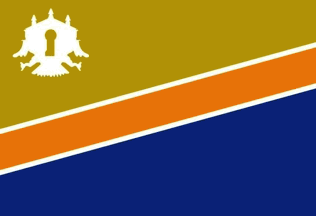 klaus-michael schneider
klaus-michael schneider
Keywords: yaracuy | san felipe |
Links: FOTW homepage | search | disclaimer and copyright | write us | mirrors

Last modified: 2021-08-26 by  klaus-michael schneider
klaus-michael schneider
Keywords: yaracuy | san felipe |
Links: FOTW homepage |
search |
disclaimer and copyright |
write us |
mirrors
 image
by Mayerling Milagros Cañizalez Salcedo, 25 March 2020
image
by Mayerling Milagros Cañizalez Salcedo, 25 March 2020
See also:
The municipality of San Felipe (220,786 inhabitants in 2001; 24,700 ha) is
the capital of Yaracuy State.
San Felipe was established at the end of
the 17th century near cocoa plantations. Originally known as El Cerrito de
Cocorote and depending on the town of Barquisimeto, the settlement was granted
the title of "ciudad" on 6 November 1729 by King Philip V, with jurisdiction on
a big territory and renamed to San Felipe El Fuerte on 1 May 1731. The king
subsequently established in San Felipe the seat of the Real Compañía Guipuzcoana
to control cocoa trade between the Venezuela province and Spain. The local
smallholders were forced to sell their harvest to the company, which retailed
them at a much higher price in the European towns.
The town was totally
rebuilt after the earthquake that destroyed Caracas and several other towns on
26 March 1812, killing 15,000-20,000.
https://bitacoradelcronistasf.jimdofree.com/crónicas-i/el-d%C3%ADa-de-san-felipe-es-el-1ero-de-mayo/
Ivan Sache, 25 March 2020
The flag of San Felipe was designed by Mayerling Milagros Cañizalez Salcedo
(b. 1989), winner of a contest organized on 7 March and 4 April 2014 by the
Municipality and the Office of the Official Chronicler. The flag was inaugurated
on 6 November 2014 (to be subsequently celebrated as San Felipe Flag Day) in the
Archeological and Historical Park of San Felipe El Fuerte.
The author
obtained in 2012 a B.Sc in Design (1st out of 61 students) at Universidad
Nacional Experimental del Yaracuy (UNEY) and was hired the next year by UNEY to
teach design.
The flag is composed of two horizontal stripes, golden
yellow on top and blue on bottom, separated by an orange ascending diagonal
stripe outlined in white. A white symbol is placed in canton.
The golden
yellow stripes represent the exuberant natural resources, such as the forests,
the flora, the fauna and river Yurubí, as well as the cultural heritage and
people's knowledge.
The orange stripe symbolizes the idiosyncratic spirit
of the people of San Felipe, which defines them as enthusiastic, friendly,
joyous and warmhearted. The ascending stripe suggests the dynamism and energy of
people building day after day a better municipality.
The white outlines
surround the orange stripe as a symbol of protection and kindness.
The
blue stripe represents the sky and water, reflected in rivers Yurubí and Yaracuy
and in the faith of persevering people, which cover like a protecting coat the
blessed soil and the people.
The emblem, shaped like a lock, is a tribute
to the old town of San Felipe. It is the graphic synthesis of two emblematic
icons, on top, the entrance gate of the San Felipe El Fuerte Archeological
Historical Park, on bottom, the wings and feet of the double-headed eagle
featured on a lock found in the remains of the old town.
https://bitacoradelcronistasf.jimdofree.com/crónicas-ii/la-bandera-de-san-felipe-enaltece-nuestro-gentilicio/
Website of the official Town's Chronicler
The site of the old town of
San Felipe El Fuerte, destroyed in 1812 by an earthquake, was made a
Recreational Park by Decree No. 1,686 issued on 7 March 1974. Remains of the
church, the cemetery, the jail and of a few houses are still visible among a
profuse vegetation
Decades ago, a farmer plowing a plot on the site
discovered human bones and silver coins. An international scientific team
identified the remains of 122 people, including a man of 2m in height, probably
the guardian of the town.
https://archivo.elpitazo.net/occidente/al-parque-arqueologico-san-felipe-el-fuerte-le-falta-carino/
El Pitazo, 25 February 2017
Ivan Sache, 25 March 2020